Spruce "Fat Albert": description, features of planting and care, reproduction
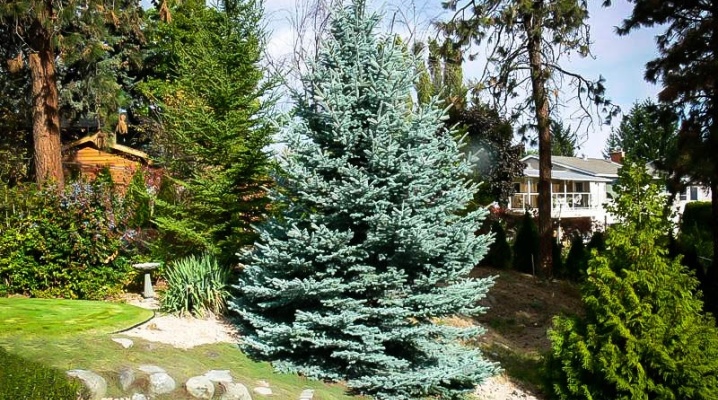
Fat Albert spruce is a coniferous tree with a beautiful blue crown, which is the result of natural, natural selection. This is a fairly young coniferous species, discovered in the 70s of the last century. Due to its extraordinary color and geometrically correct shape, it is considered one of the most popular types of spruce.
Spruce variety description
The Fat Albert coniferous tree adjoins a group of spruces with a wide conical shape and special proportionality, it grows extremely rapidly - up to 20 cm per year. Mature trees of this species reach 15 meters in height and 3-4 meters in diameter. At the age of 10, the spruce grows up to 3 meters.
Characteristic features of an evergreen, or rather, an evergreen plant:
- strong and durable, densely growing branches located perpendicular to the trunk indicate the tiered structure of the tree;
- sharp, prickly needles of the needles reach 2-3 cm in length and are distinguished by a blue tint that does not fade throughout the year;
- cones that form in spring are oblong, sometimes egg-shaped, have a violet-green color and look beautiful on gray twigs, over time they will turn brown.
The advantage of this variety is that the silvery-blue color of the tree does not change throughout the year, moreover, its age does not affect the color of the spruce.
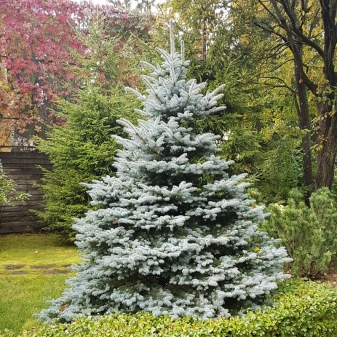
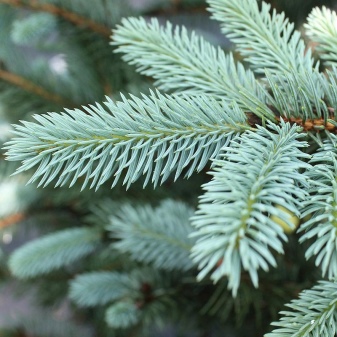
Other characteristics of this coniferous culture:
- has increased winter hardiness and withstands sub-zero temperatures below -35 degrees;
- loves light, is quite resistant to an arid climate, but, growing in it, grows much more slowly;
- feels good on fertile, loose soils with good drainage;
- with strong moisture, the spruce is susceptible to the influence of fungal microorganisms, its branches wither and can crumble;
- the branches of the plant can withstand high loads, so they are not afraid of the abundance of snow.
- "Fat Albert" can get sick only due to improper irrigation, strong soil acidity, stagnation of moisture in the soil.
The tree is not susceptible to pests and feels great in urban conditions - the impact of gas-polluted air, pollution and the presence of smoke in the atmosphere does not actually affect its vitality and beauty. Thorny Christmas tree "Fat Albert" is rightfully considered one of the best types of blue spruce and is a worthy decoration of private and public territories.
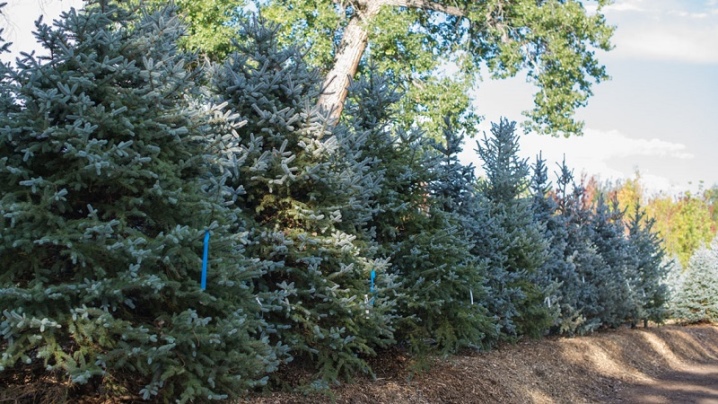
Breeding and planting features
Since the blue thorny spruce is not as shade-tolerant as compared to ordinary spruce, it is recommended to plant it in open areas of the site. Before that, it is worth making sure that the groundwater is deep enough, and the place will not be subject to spring floods and waterlogging. The coniferous tree Fat Albert is quite picky about the composition of the soil, the plant can react especially sharply to increased acidity. It is also demanding about the fertility of the land. The ideal soil is loam and sandy loam soils with a low percentage of acid and a significant thickness of the drainage layer.
Reproduction at home is carried out in two ways - by growing seeds and by cuttings. To get the seeds, the cones are brought home in the winter, after their opening, the seeds are carefully removed, placed in moist sand and kept in a cold place.In the spring, before planting, they must be treated with a solution of potassium permanganate for disinfection and prevention of fungal diseases. Planting takes place from early May to late June.
The substrate for seedlings is a mixture of peat (1 part), sand (1 part), leaf and turf soil (2 parts of each component). The seeds are sown in a container or large boxes to a depth of 2 cm and spill the soil well.
After the seedlings grow up, they are seated more spaciously, at a distance of 30 cm from each other, and at 3 years old - with an interval of 1 m.
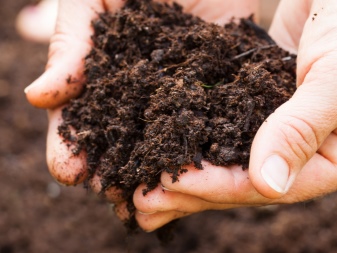

It is much easier to root the cuttings of a plant. This will require:
- in spring, cut off young shoots of mature spruce with a piece of wood;
- clean the lower part of the needles;
- process with potassium permanganate;
- plant in planting holes with a soil substrate and drainage, which is used as crumbled brick, pebbles or gravel;
- place the seedling in the ground to ground level and compact it slightly;
- water the plants abundantly and cover them with foil;
- then watering is required up to 4 times a day, and closer to winter - mulching with bark, sawdust and peat.
It is advisable to shade young plants from direct sunlight, as they can burn tender young twigs. In principle, you can buy a ready-made seedling. Of course, it is better to purchase it in a specialized nursery with a closed root system. When planting, the plant is placed in the ground along with a lump of earth.
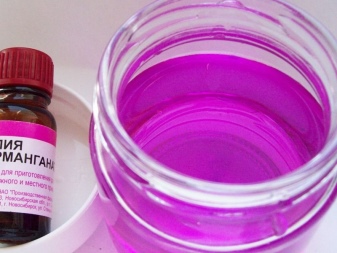

How to care for Fat Albert spruce?
Caring for blue spruce includes procedures familiar to all gardeners.
- Regular irrigation, especially for young trees. They are watered daily 2 times with warm water, in addition, the green mass is moistened by spraying. Sprinkling the crown is best done in the evening. It is recommended to increase watering on dry, hot days.
- Fertilization is relevant for the first 5 years of crop cultivation. This requires periodic feeding with mineral compositions containing nitrogen, phosphorus and potassium, and in a dosage designed specifically for conifers. It is categorically impossible to fertilize the blue thorny spruce with organic matter - humus and manure. The first feeding is carried out in early spring, after the snow has melted. They are applied directly into the soil of the near-stem part and slightly compacted. Adult plants do not need fertilization.
- In order to prevent the formation of an earthen crust, the soil near the plant trunk should be loosened, and also cleaned of weeds. Digging is undesirable so as not to damage the root system.
- In case of unfavorable environmental conditions and strong gas contamination, spruce can be washed once every 30 days.
- One of the important points in the cultivation of ephedra is the mulching of the soil with a peat composition.
- Crown pruning is done as needed, for example, when it is necessary to remove dry and diseased branches, but this is allowed only in summer. If you cut the spruce shoots in the fall, this can cause the tree to freeze. When pruning, gardeners usually do not use garden pitch, since the tree heals itself on its own, with its own resin.
- Artistic crown shaping is done only for young trees up to 7 years old.
- In preparation for winter, branches growing in the lower part of the trunk are tied to it only in young trees.
Diseases that can affect the Fat Albert spruce are ulcerative cancer, fusarium, bark necrosis, rust, fungal infections (shute), rot developing on the branches and trunk. Of the pests, the most dangerous for the tree are the spruce sawfly and the red spider mite. Timely inspection of trees and their treatment with insecticides and fungicides will help protect plants from damage. For diseases, you can use Bordeaux mixture, copper oxychloride and other preparations with its content. To protect the spruce from insects, you can purchase products such as "Aktara" and "Decis".

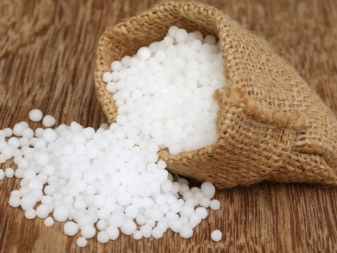
Application in landscape
Colorado prickly spruce can be used in different ways:
- coniferous tree is suitable for decorating the front entrances of public and state institutions;
- for the design of parks and squares;
- solitary plantings make individual trees bright accents on lawns in combination with other plants and flowers;
- group landings are used to create alleys;
- flawless use of the plant in decorating private areas.
In your own garden, you can leave the tree in splendid isolation and lead round dances around it for the New Year. However, there is a more interesting option - you can create a unique composition of coniferous trees: plant next to the American beauty a spruce "Bialobok", ordinary spruces, as well as spherical thuja, fir trees, dwarf pines and cypresses. Such an ensemble will perfectly fit undersized shrubs such as barberry, small bushes of miniature roses, variegated perennial herbaceous plants - lungwort, geychera, shade-loving forget-me-not flower.
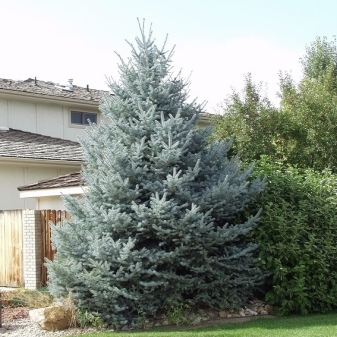
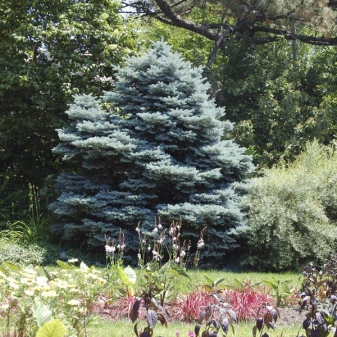
The Fat Albert variety is an expensive pleasure for a gardener, nevertheless, its presence on a garden plot can transform the territory, so the tree is in high demand.
In the next video, you will find more information about the Fat Albert spruce.



































































The comment was sent successfully.